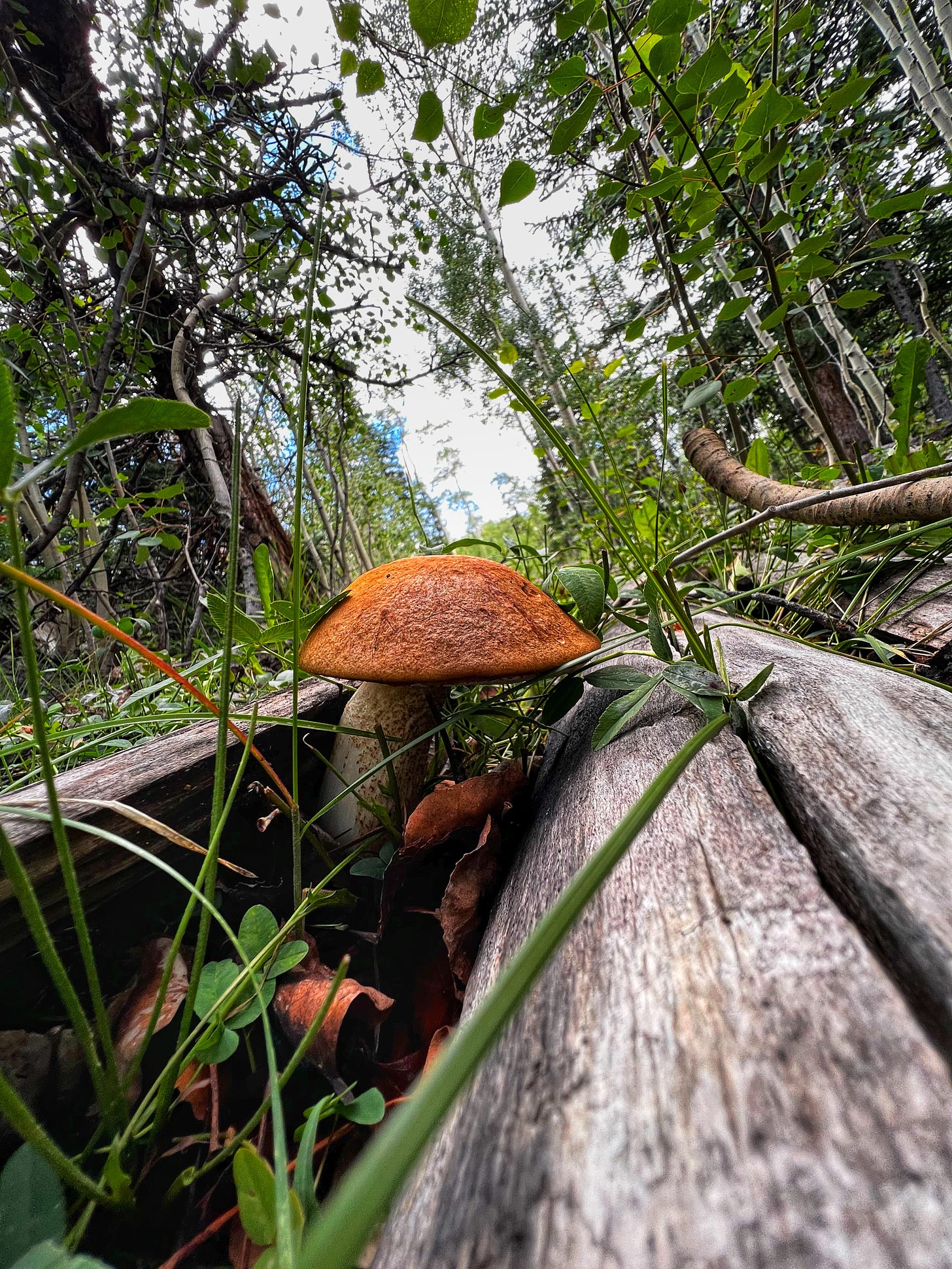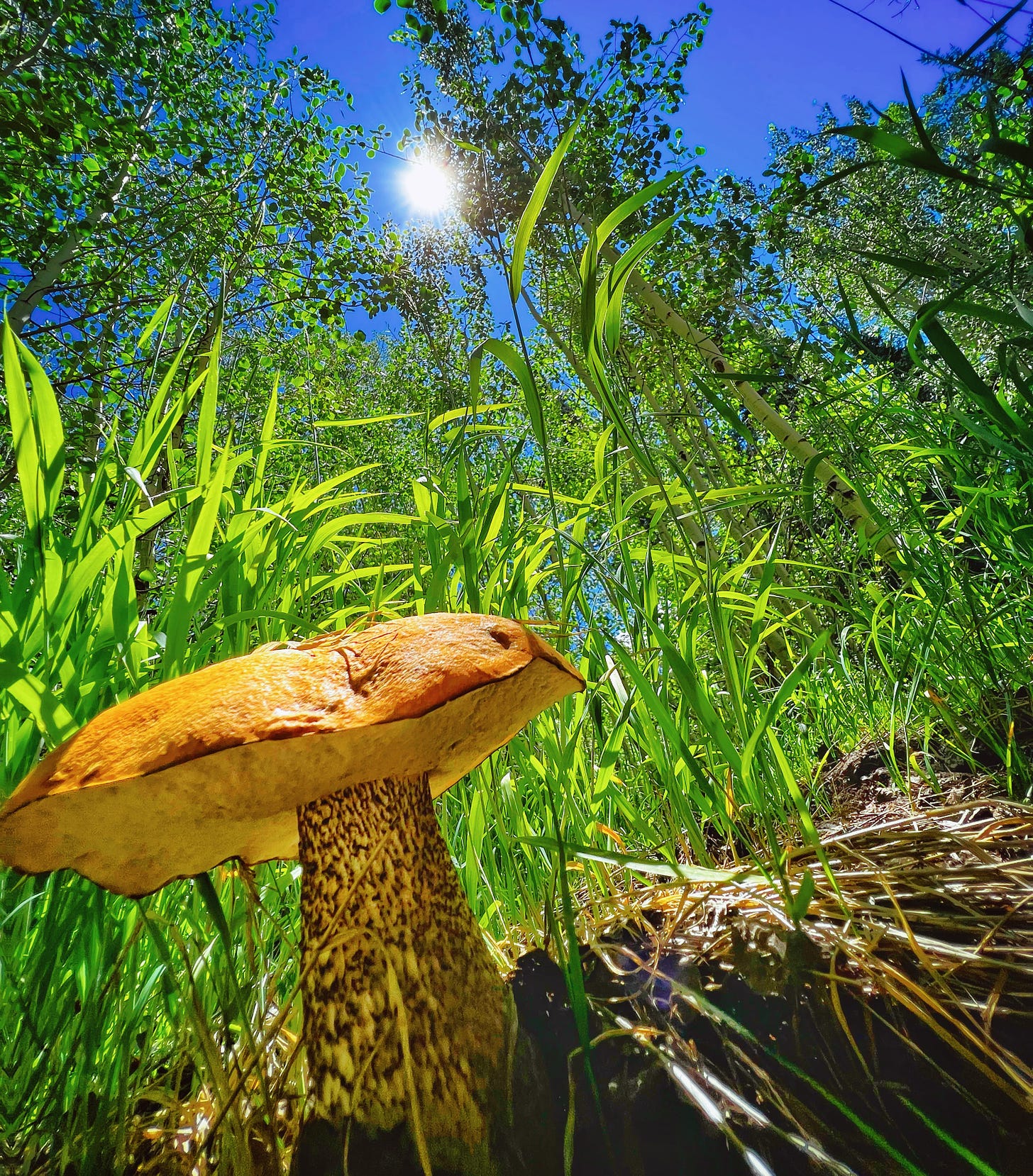Why Photographers Should Make Writing Well a Priority, and, of course, Mushrooms.
Writing, whether formal, for social media, or business opportunities, can make all the difference. Even in the visual context of our work.

Good morning Framers!
An absolutely gorgeous sunrise this morning in the desert. Roosters are having their contest, and the light just skimming the saguaros makes the spines look like they were made of silver.
Hey, it’s even chilly on the porch this morning.
What’s up with that?
Oh, and here’s a handy little note. Did you know you can use your iPhone and Google Photos to determine what kind of plant is in front of you?
We have this really weird plant that sprung up in the corner of the yard, and it has the most beautiful, large yellow flowers on it.
There is nothing like this around us, nor have we ever seen this flower before.
Took a photo of it, put it on Google Photos, brought it up on the iPhone, and clicked the lens icon at the bottom. Boom: Africa Tree… whatever that is, we have one.
On to today’s post.

Here’s a non-shocking statement; Writing well creates more opportunities
Almost all of our business is now conducted in written form.
Contacts.
Proposals.
Emails.
Social Media.
Blogs and Journals
Contracts
Briefs
Books
I have vague memories of discussing gigs on the phone.
I was reminded of that experience this week when a new partner and I were discussing an upcoming project and we were doing it on the phone.
Yep, not a Zoom, or a Hangout, or a VOIP, or Skype, or Googleythingy…
A phone.
I had my trusty Field Notes out and was making little scribbles of barely legible DonnyGlyphs as we planned our next steps.
Deja Vu, I thought as I hung up.
Up until that time, and going forward, we will be back to written communications.
Email, messages, texts.
Part of the reason for the phone call was expedience for both of us. The topics were changing fast and the back and forth was imperative to be done fast and agreed on.
We were both mobile, so Zoom was out of the question.
It gave me pause to realize how important writing has become in most of our lives.
BiTD, phone calls were the thing we spent most of our time doing.
Now, it is writing.
And I think writing well is one of the most important things a photographer can do to set themselves apart.
No, you ain’t gotta be no Hemingway, you just gotta be competent.
(I was lucky enough to take a writing course I found on the back of a book of matches, “How to Write Good”. Cost me $50 bucks and I got good enough that I did the follow-up course, “How To Write Gooder”. It was money well spent, brother.)
1. Writing Proposals: Securing Opportunities
Writing proposals is a very big part of what we do, and what we need to do to get work.
Whether answering a request for a proposal, or writing a pitch to a publisher, our command of the written word can be a deciding factor when they begin the consideration process.
Being crystal clear, decisive, concise when needed, and on point can give the reader a much more positive look at what you are offering.
And to add to this the fact that our bad grammar may cause someone to have a hernia right there in their office just makes it all the more imperative that we use grammar well.
2. Crafting Professional Emails: Building Client Relationships
I opened an email from a photographer recently, and it was one of the catalysts to this article.
No greeting.
Bad spelling (typos… or….worse?), a disjointed message that had me wondering if she was trying to sell me something or buy something. And no, it wasn’t a non-English writer.
No footer, or signature.
Just. Bad. Business.
I ended up ignoring it because, well, ain’t nobody got no time for dat.
It could have been a sale, or it could have been an opportunity. But it was lost in the fact that it was incomprehensible, and working with people who do not communicate well is very difficult.
I know you know what I mean.
(Yeah yeah, I’ll find out someday that she was trying to offer me $11BN dollars and I am a total putz for blowing her off. Sucks to be me.)
3. Blogging and Journaling: Sharing Your Photographic Journey
I am still a big believer in the photographer’s blog. I wrote several articles about the switch to ‘platforms’ that everyone glommed on to back 2012 or so.
“We don’t need to blog, we have Facebook. It’s free and we can have these cool “Fan Pages” where we can do everything for free. Did I mention it was free!”
I said it then, and I’ll say it now: do not plant your field on someone else’s land.
Facebook killed the free fan pages one bright and delightful morning and demanded that people pay to advertise their fan pages to the very people who signed up to be on the fan pages.
And there was absolutely nothing you could do about it.
Write your blogs, keep your online Journals.
They are yours: your field, your land, your writing.
For one thing, they are vital for SEO. (I know you are sick of hearing about SEO, but it is a very real thing.)
A few practical reasons beyond the vital SEO stuff.
Writing about your photographs provides you with fodder for more writing. And people love to read about photographs, their making, and the reasons behind their creation.
It is a wonderful way to get to know your own work. I am not kidding. In my mentorships, I have the photographers write about their own images. Not novels, just a few lines. Everyone agrees; they begin to see their work in new ways, and the desire to do more work increases to a fever pitch. (That’s a good thing, no need for Tylenol or a mask.)
Eventually, you may have enough writing and images that a book is just a matter of assembly. Creating slowly and steadily instead of sitting down and trying to do it in a few weeks or months. One blog post a week is 52 images and accompanying writing and that is a pretty good-sized book.
4. Describing Your Work: Articulating Vision and Intent
As I mentioned above, being able to write about photography helps you see better photography, whether as a print before you or a vision through the viewfinder.
And writing about other people’s photography is one of the ways you can expand your knowledge and visual literacy.
Here’s an exercise:
Choose ten of your favorite photographs made by other photographers. Write a paragraph about each one. Choose a writing voice that is you… funny, analytical, educational, whatever.
Choose ten of your favorite photographs - the ones you made - and do the same thing. Did you notice any commonalities?
Write a short story about a few of your images. Fictional or non-fiction. A fictional short story (300-500 words) is so much fun to do. And a 500-word description of how you found and made that image can be a blast to write and share.
We did this at Project 52 a few years ago. You can get a hardcopy at Blurb, or download the PDF for free here (sorry, no cover page.
5. Marketing and Social Media: Reaching a Wider Audience
Whether you are working professionally or just having a blast with photography, we all end up sharing images on social media.
Being able to write a strong caption or give the information a potential client may need is vital for extending your reach.
Badly written LinkedIn articles or posts will never raise your visibility, except maybe to go viral for a faux-pas you didn’t catch and now you are the laughing stock of Twitter… I mean X.
LinkedIn and Behance are the two most professional social media sites for photographers, and both require strong writing skills. At least as strong as you can make them.
I said above that photographers should blog on their own sites, and here I am writing on Substack. You should also be writing and sharing your work on Substack.
And your own blog.
There are many more reasons a photographer should upgrade their writing skills.
In The Creative Class, we are expanding photographer’s skill sets to prepare them for the changing needs of today’s clients.
Graphic and motion design, e-commerce and web design, and writing are some of the tools that a modern photographer must adopt to become a stronger partner with businesses that are increasingly in need of more varied visual work.
Adapt or die, someone wise once said.
Imagine having a dozen subscription or retainer clients paying $1200 - $4000 a month for your visual design and photography. NOT a pipedream at all.
There are many good writing classes out there.
I have taken Ash Ambirge’s twice and really love it.
It isn’t a semantics or diagramming sentences sort of thing, it’s a kick-ass engage with your reader sort of thing. You can find out if she is doing another one by following here.
Look for those workshops that focus on B2B writing would also be a suggestion. If we are thinking pragmatically, that is what we need to get right.
Thank you for supporting me and following along on my journey. Getting back into some semblance of normality while being homeless and living in my daughter’s house while awaiting ours to sell and construction to begin is maddening.
But getting better.
When you are ready, here is how I can help you succeed.
Group Mentorship: a small group of photographers who meet to show images, work on their portfolio, and build their businesses with help from a wonderful group. Lifetime membership for one fee.
One-on-one Mentorship: You and me - working together in an intense 6-month push to get you on the way to over $30K in revenue if you are making less and over $60K if you are already making around $30K.
The Creative Class: Expand your toolset and become a one-person visual agency capable of pulling in steady and repeated income. If you have questions, let me know, and I will answer them as fast as possible.
Discount codes for In the Framers:
Cohort Discount $197: $1000 | A23CD7E72E
Creator Discount: $100: $197 | 2BA98E4053
Keep reading with a 7-day free trial
Subscribe to In The Frame to keep reading this post and get 7 days of free access to the full post archives.







